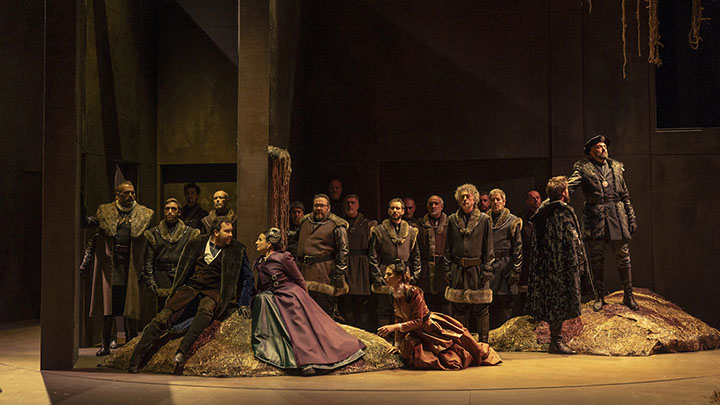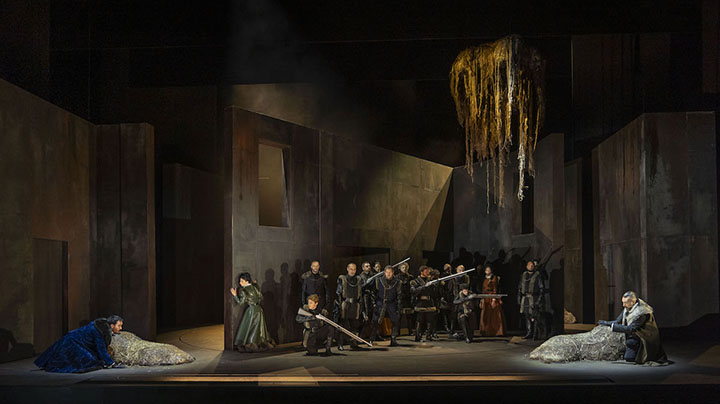
There are many reasons for this: the extreme length of the score (over 3 hours of music), its tiresome beginning (the Overture is uninteresting and the protagonist’s Cavatina is unsatisfying), the comparative difficulty of the full-length tenor part (often drastically cut), the lack of an aria for the bass (the very first performer, Filippo Galli, didn’t like solo pieces). But after the revival of the opera by Maria Callas, the interest that many prima donnas of the 20th century had in the unfortunate Queen Anne Boleyn ensured that almost all the great subsequent sopranos performed it.
Certainly, the Anna Bolena that can be seen and above all heard in these weeks on some stages of Emilia, in Northern Italy (Reggio, Piacenza, Modena), is very different from the one that what Italians call “melomani” have learned by heart from the 1957 La Scala recording with Maria Callas and Giulietta Simionato under the direction of Gianandrea Gavazzeni. In contrast to the many cuts in that historic performance, the director Diego Fasolis offers an almost complete text; and being able to enjoy so many cabalettas repeated in arias and duets is an experience to which we are still not accustomed, despite much talk today of ‘historically informed performances.’ The basic principles of the historical musical practice are instead well present in Fasolis’s musical direction, starting with the many vocal appoggiaturas (not always prescribed by Donizetti but always performed by the singers) where necessary.
The most evident impact, however, came from the orchestra: not the traditional late-Romantic ensemble but a very plausible orchestra of early-Romantic inspiration not dissimilar from the ones that Mozart and Rossini must have known. The ensemble I Classicisti (the evolution of I Barocchisti previously created by Fasolis, as well) brings to the nineteenth century the experience of ancient instruments, natural horns, lowered diapason, restrained vibrato, and generally drier, lighter sounds, despite the often bold attitude of the tempi and the clamor of the brass instruments and percussion. The use of a special orchestra would not be possible, in Italy, in higher-level theatres, that is, in those companies that have a house orchestra and choir: this is one of the reasons why it is so rare to see a Handel or Vivaldi opera in a major Italian theater (which would have to leave a regularly paid symphony orchestra and choir at home for the entire duration of the production), while it is much more common in the so-called ‘traditional theatres,’ without a stable orchestra, who can thus hire the most suitable staff depending on the work presented.
The use of a ‘period orchestra’ allowed Fasolis to lighten not only the instrumental texture but also the entire vocal company. Carmela Remigio is far from the dramatic soprano that we usually associate with Anna Bolena. And equally far from the traditional rendition of a mezzo-soprano was the Giovanna Seymour offered by the very talented Arianna Vendittelli, a true soprano, too. With them, Fasolis recreates the effect of the two high prima donnas in amorous contrast on which Bellini’s Norma was also originally conceived.
The overall effect is truly interesting, helping to realize with the singing that feeling of mutual compassion between the two women mentioned in the libretto, instead of the relationship of subjection that the differing vocal ranges would portray. Their duet in the second act was among the most moving pages of the night. Unfortunately, however, the best-known piece of the score went unnoticed: in “Al dolce guidami castel natio,” Bolena’s slow and ecstatic Act II mad scene, the conductor has deprived it of its typical character. On the contrary, Bolena’s heartbreaking madness emerged with all its power in the final double cabaletta which appeared one of Remigio’s most convincing moments.
The bass Simone Alberghini, by this point far along in his career, overcame a blurred vocal emission with a peremptory stage presence that was well suited to the arrogant Enrico VIII. The tenor Rüzil Gatin was the revelation of the evening: he gave the right depth to the character of Lord Riccardo Percy, usually overshadowed by the two women, and with his clear, very extended and confident voice, he could boldly face even the prison scene which is too often subjected to radical cuts due to the impossibility of finding suitable performers.
The supporting characters were also very good: the mezzo-soprano Paola Gardina in the part of the musichetto Smeton and the baritone Luigi De Donato as Lord Rochefort, were impeccable both vocally and in the scenic definition of their characters. On the contrary, every single phrase uttered by the tenor Marcello Nardis in the small part of Sir Hervey was unpleasant to hear; he was, indeed, the only real weak point of the singing company in the first Italian appearance of this show.
The production was in fact born in September in Lugano, in Italian-speaking Switzerland, where opera strangely lacks the foothold it has in the large German- and French-speaking Swiss cities. The installation designed by Carmelo Rifici for the cultural center LAC (Lugano Arte Cultura) makes use of the pseudo-historical costumes of Margherita Baldoni, simple and linear, perfectly complemented the rough and geometric scenes by Guido Buganza, whose walls often move in a circular manner to recreate the various environments in a few moments. All in all it is an effective and intelligent production, but for the useless and incomprehensible modernist incursion of two house painters drawn from the contemporary world sponging down a wall of the stage during the Overture: it’s true that Donizetti’s music is not at its best in that moment, but preventing us from listening to it calmly, due to excessive visual distraction, is perhaps not the best solution.
Photos: © LAC – Masiar Pasquali; © LAC – Anna Domenigoni



























Comments